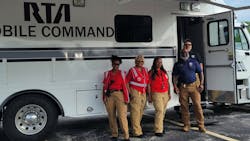GCRTA transit ambassador program; how it’s going
For the past two years, the Greater Cleveland Regional Transit Authority (GCRTA) has been integrating civilian transit ambassadors on buses and trains in place of police officers to maintain a safe and comfortable travel environment for its riders. The program aims to help riders feel more at ease as they make their commutes to and from work, school and day-to-day errands. This initiative was a part of the GCRTA transit ambassador program which was launched in September 2022.
This "progressive policing and community engagement" initiative was designed to decrease the presence of armed law enforcement on the GCRTA system and was initially modeled after the Bay Area Rapid Transit Authority’s (BART) own transit ambassador program.
With their red vests and khaki pants, GCRTA transit ambassadors can be found on buses, trains, stations and in and around transit facilities. Ambassadors are often paired with crisis intervention specialists (CIS), who are licensed social workers embedded with transit police officers. The CIS team is equipped to assist in the event of a mental health episode or crisis situation.
GCRTA CIS Joyce Glenn says that “getting someone connected to services when they are experiencing a mental crisis or substance abuse and they're looking to get connected to rehab,” is what CIS often see when they are reporting to a scene on GCRTA.
As a team, transit ambassadors and CIS work to ensure the safety of riders and transit employees.
Transit ambassadors' responsibilities include:
- Provide general information and assistance to riders and the public.
- Assist riders needing help with navigating GCRTA’s transit system.
- Assist riders in understanding and complying with fare policies.
- Request transit police assistance as needed.
- Help maintain a safe and clean environment.
Crisis intervention specialists’ responsibilities include:
- Perform mental health, crisis and substance abuse outreach.
- Defuse immediate crises and serve as a gateway to available resources.
- Establish relationships with social service agencies.
The transit ambassador program was introduced as an opportunity to reconnect with riders and bring a fresh face to transit safety and security at the start of GCRTA Chief of Police Deirdre Jones’ leadership at the agency.
Chief Jones came into the agency in 2021 wanting to serve her community effectively. One of her first initiatives was to launch the GCRTA’s transit ambassador program.
The program aimed to help riders and community members feel safe and secure while reducing tensions in the months following the killing of George Floyd by a Minneapolis police officer in May 2020.
“After the George Floyd incident, calls for defunding the police were out there and they were pretty loud,” Chief Jones said. “What I believe is that we should not defund the police, but restructure how we do our community engagement.”
“What I believe is that we should not defund the police, but restructure how we do our community engagement.”
Transit ambassadors and CIS have received 40 hours of crisis intervention team training along with training on de-escalation, defensive tactics, First Aid/CPR/Narcan, human trafficking awareness and customer service.
A transit ambassador is also given the chance to be on scene as soon as an issue arises as they patrol on foot or during their shift riding a bus or train.
“We've had instances where there was someone in need of first aid on scene and [transit ambassadors] were able to jump in with their training and assist and call for EMS, additional assistance and things of that nature,” commented GCRTA Transit Police Commander Orlando Hudson. “So, all things non-criminal, they've been able to assist with the police department.”
Training for success
The transit ambassador program is a rising GCRTA initiative that continues to grow. Chief Jones says the success of the program is visible in the growing number of transit ambassadors and social workers that have passed through the trainings. The program began with six ambassadors and 10 social workers and has now grown to 16 ambassador with four social workers.
In a classroom setting, trainees review de-escalation tactics and procedures with a focus on customer service. They are then taken into the field for hands-on training, something Chief Jones has participated in.
“Once they pass the training program, they're brought in and given refreshers on de-escalation and scenarios where they're actually helping somebody who may be in physical distress or medical distress,” Chief Jones said.
Chief Jones continues by describing one of the scenarios she participated in saying, “I was the uncooperative passenger and I had to interact with them to see how they reacted in that particular situation.”
Being an active participant in these training sessions gives her the chance to see what her program is accomplishing through her trainees’ abilities to handle conflict and maintain safety.
The GCRTA Police Department plays a major role in the fieldwork training that goes into getting ambassadors ready to be out on their own. GCRTA Police officers take on the roles of transit ambassadors to lead trainees in the field. Trainees are able to shadow professionals to learn correct safety, de-escalation and customer service procedures.
The numbers don’t lie
GCRTA’s ridership has been surveyed in 10 waves thus far to gauge their transit experience since the ambassador program’s launch. The surveys were conducted using the methodology of a randomized intercept survey of approximately every fourth boarding customer across GCRTA’s three offered services (fixed route, bus rapid transit and rail). Yielding a ±5% margin of error at the 95 percent confidence level, an estimated total of 1,341 surveys were completed during the 10 waves and results were compared to industry partners including VIA Metropolitan Transit, Charlotte Area Transit System, Transit Authority of River City, Denver Regional Transit District and others. Data results show that riders are seeing a difference in service and transit experience overall.
Wave 6 - June 2023
The sixth wave of surveys occurred in mid to late June 2023. Data results showed that riders are more likely to recommend GCRTA services to others than they were in Wave 5 (March 2023).
Two out of three customers said they were satisfied or very satisfied with the service, which is slightly down from previous waves. Customers said they were most satisfied with vehicles being operated safely (fixed route, bus rapid transit and rail).
GCRTA’s paratransit Net Promoter Scale (NPS) increased by five points, from 65 in Wave 5 to 70 in Wave 6, 20 points higher than the industry average of 50.
Wave 10 - June 2024
In the tenth wave of surveys that occurred in June 2024, GCRTA saw a 19-point increase in the agency’s NPS to 70, indicating that customers are more likely to recommend GCRTA services to others than they were in Wave 9.
Rider feedback shows an overall 73 percent of customers are satisfied or very satisfied with the service, which is up for the third consecutive wave.
In the tenth wave, GCRTA’s paratransit NPS increased by nine points, from 65 in Wave 9 to 74 in Wave 10. It is now 22 points higher than the TransPro agency average of 52.
A growing movement
The GCRTA has been asked by neighboring agencies to give them pointers as the idea of a transit ambassador program begins to grow within the transit industry.
GCRTA Transit Police Lieutenant Richard Kopp, an organizer in the agency’s transit ambassador program, recommends agencies conduct constant training and consistently encourage trainees to learn about the environment in which their agency is operating. Lieutenant Kopp also recommends integrating ambassadors further into an agency and increasing awareness for them within the company.
“I would recommend constant interaction with employees as it is also important because other GCRTA employees sometimes don't know the ambassadors exist,” stated Lieutenant Kopp.
Looking forward
Moving forward GCRTA will be expanding its outreach to bring more interest to a transit ambassador career within the agency. Creating strength in numbers will help the agency to better distribute its employee base and cover more ground within its system.
“Ultimately, we would like to see [transit ambassadors] increase as far as staffing levels and as they increased, we would like to spread them throughout the system,” Commander Hudson said.
The agency is currently down one crisis intervention specialist and three transit ambassadors.
“We're looking at bringing on one ambassador immediately, hopefully within the next two weeks and we're looking at bringing on a crisis intervention specialist, hopefully within the next month,” added Commander Hudson. Currently, we're budgeted for four CIS and we're budgeted for 16 ambassadors. So we're interviewing constantly. We're in the process of revising and posting the crisis intervention specialist position.”
Transit ambassadors have solidified their place within the GCRTA system.
“We're basically extra eyes and ears for the RTA police,” stated GCRTA Transit Ambassador Herman Maxie. “Anything they can't take care of; we will take care of. You have people that need fare help or directions or you find people in trouble. We call CIS to come help them with food, shelter and anything like that. Any programs they need, we have a lot of backup. We can get the public help they need.”
About the Author
Eman Abu-Khaled
Associate Editor
Eman Abu-Khaled is a former associate editor with Mass Transit magazine.


